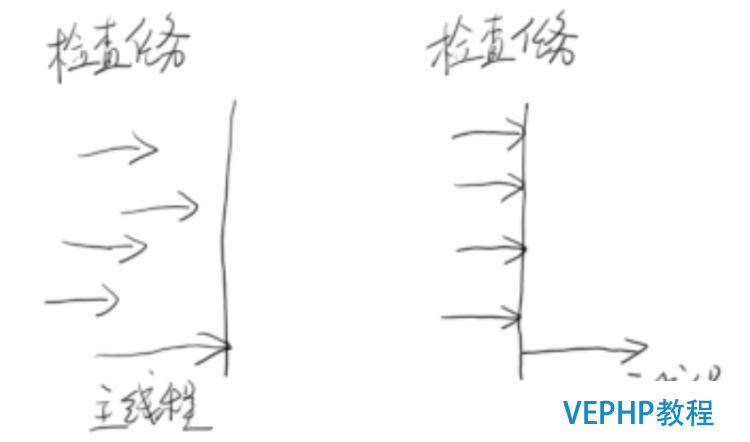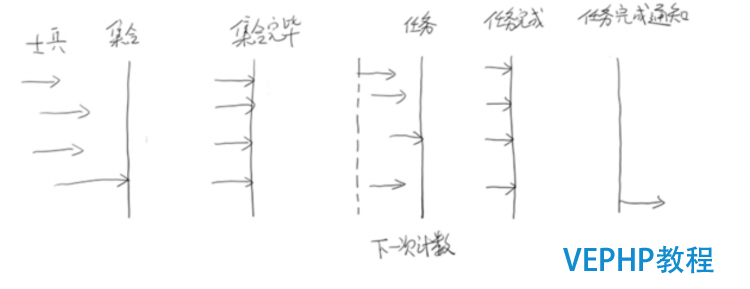LINUX實戰:各種同步控制工具的使用
《LINUX實戰:各種同步控制工具的使用》要點:
本文介紹了LINUX實戰:各種同步控制工具的使用,希望對您有用。如果有疑問,可以聯系我們。
Semaphore
概述
共享鎖,運行多個線程同時臨界區
主要接口
public void acquire()
public void acquireUninterruptibly()
public boolean tryAcquire()
public boolean tryAcquire(long timeout, TimeUnit unit)
public void release()
使用
public class SemaphoreDemo {
? ? private static final int THREAD_COUNT = 3;
? ? private static ExecutorService threadPool = Executors
? ? ? ? .newFixedThreadPool(THREAD_COUNT);
? ? private static Semaphore s = new Semaphore(1);
? ? public static void main(String[] args) {
? ? ? ? for(int i=0;i<3;i++)
? ? ? ? {
? ? ? ? ? ? threadPool.execute(new Runnable() {
? ? ? ? ? ? ? ? @Override
? ? ? ? ? ? ? ? public void run() {
? ? ? ? ? ? ? ? ? ? try {
? ? ? ? ? ? ? ? ? ? ? ? System.out.println(Thread.currentThread().getName()+"start data");
? ? ? ? ? ? ? ? ? ? ? ? Thread.sleep(2000);
? ? ? ? ? ? ? ? ? ? ? ? s.acquire();
? ? ? ? ? ? ? ? ? ? ? ? Thread.sleep(1000);
? ? ? ? ? ? ? ? ? ? ? ? System.out.println(Thread.currentThread().getName()+"save data");
? ? ? ? ? ? ? ? ? ? ? ? s.release();
? ? ? ? ? ? ? ? ? ? ? ? System.out.println(Thread.currentThread().getName()+"release data");
? ? ? ? ? ? ? ? ? ? ? ? Thread.sleep(2000);
? ? ? ? ? ? ? ? ? ? ? ? System.out.println(Thread.currentThread().getName()+"end data");
? ? ? ? ? ? ? ? ? ? } catch (InterruptedException e) {
? ? ? ? ? ? ? ? ? ? ? ? e.printStackTrace();
? ? ? ? ? ? ? ? ? ? }
? ? ? ? ? ? ? ? }
? ? ? ? ? ? });
? ? ? ? }
? ? ? ? threadPool.shutdown();
? ? }
}?最后得出一個比較有意思的結論:Semaphore 像是一個共享的屋子,這個屋子里面只能有一定的人數,這個人數是所有人可以看到的,甚至與release()這個辦法,可以被別的線程進行調用,
一般使用acquire()? 與release() 這個之間的代碼只能有固定數量的線程存在,當然這種是當火線程進行獲取和釋放
ReadWriteLock
概述
ReadWriteLock是JDK5中提供的讀寫分別鎖
主要使用
private static ReentrantReadWriteLock readWriteLock=new ReentrantReadWriteLock();
private static Lock readLock = readWriteLock.readLock();
private static Lock writeLock = readWriteLock.writeLock();
這個類如果沒有寫鎖的情況下,讀是無阻塞的,在必定程度上提高了程序的執行效率.
public void run() {?
? ? ? ? ? ? ? ?//isRead自界說變量(判斷這個線程是讀還是寫)
? ? ? ? ? ? ? ?if (isRead) {?
? ? ? ? ? ? ? ? ? ? ? ?//獲取讀鎖?
? ? ? ? ? ? ? ? ? ? ? ?myLock.readLock().lock();?
? ? ? ? ? ? ? ? ? ? ? ?System.out.println("讀");
? ? ? ? ? ? ? ? ? ? ? ?//釋放讀鎖?
? ? ? ? ? ? ? ? ? ? ? ?myLock.readLock().unlock();?
? ? ? ? ? ? ? ?} else {?
? ? ? ? ? ? ? ? ? ? ? ?//獲取寫鎖?
? ? ? ? ? ? ? ? ? ? ? ?myLock.writeLock().lock();?
? ? ? ? ? ? ? ? ? ? ? ?//執行現金業務?
? ? ? ? ? ? ? ? ? ? ? ? ? ? ? ?System.out.println("寫");
? ? ? ? ? ? ? ? ? ? ? ?//釋放寫鎖?
? ? ? ? ? ? ? ? ? ? ? ?myLock.writeLock().unlock();?
? ? ? ? ? ? ? ?}?
? ? ? ?}?
?CountDownLatch
概述:

static final CountDownLatch end = new CountDownLatch(10);
end.countDown();? //這個辦法是子線程作完作業之后,調用的
end.await(); //主線等待指定數量的子線程完成作業,當所有子線程完成之后,主線程自動激活執行
public class CountDownLatchDemo {
? ? private static CountDownLatch countDownLatch=new CountDownLatch(10);
? ? public static void main(String[] args) {
? ? ? ? for(int i=0;i<10;i++)
? ? ? ? {
? ? ? ? ? ?new Thread(new Runnable() {
? ? ? ? ? ? ? ? @Override
? ? ? ? ? ? ? ? public void run() {
? ? ? ? ? ? ? ? ? ? System.out.println(Thread.currentThread().getName()+"work");
? ? ? ? ? ? ? ? ? ? try {
? ? ? ? ? ? ? ? ? ? ? ? Thread.sleep(2000);
? ? ? ? ? ? ? ? ? ? } catch (InterruptedException e) {
? ? ? ? ? ? ? ? ? ? ? ? e.printStackTrace();
? ? ? ? ? ? ? ? ? ? }
? ? ? ? ? ? ? ? ? ? countDownLatch.countDown();
? ? ? ? ? ? ? ? }
? ? ? ? ? ? }).start();
? ? ? ? }
? ? ? ? new Thread(new Runnable() {
? ? ? ? ? ? @Override
? ? ? ? ? ? public void run() {
? ? ? ? ? ? ? ? try {
? ? ? ? ? ? ? ? ? ? countDownLatch.await();
? ? ? ? ? ? ? ? ? ? System.out.println(Thread.currentThread().getName()+"主線程start");
? ? ? ? ? ? ? ? } catch (InterruptedException e) {
? ? ? ? ? ? ? ? ? ? e.printStackTrace();
? ? ? ? ? ? ? ? }
? ? ? ? ? ? }
? ? ? ? },"main1").start();
? ? }
}?CyclicBarrier
概述

?
public class CyclicBarrierDemo {
? ? public static class Soldier implements Runnable{
? ? ? ? private? String name;
? ? ? ? private final CyclicBarrier cyclicBarrier;
? ? ? ? public Soldier(String name,CyclicBarrier c) {
? ? ? ? ? ? this.name = name;
? ? ? ? ? ? this.cyclicBarrier=c;
? ? ? ? }
? ? ? ? @Override
? ? ? ? public void run() {
? ? ? ? ? ? ? try{
? ? ? ? ? ? ? ? ? //等待所有士兵到齊
? ? ? ? ? ? ? ? ? System.out.println(name +"報道");
? ? ? ? ? ? ? ? ? cyclicBarrier.await();
? ? ? ? ? ? ? ? ? ? dowork();
? ? ? ? ? ? ? ? ? //等待所有士兵完成工作
? ? ? ? ? ? ? ? ? cyclicBarrier.await();
? ? ? ? ? ? ? }
? ? ? ? ? ? ? catch (Exception e)
? ? ? ? ? ? ? {
? ? ? ? ? ? ? ? ? e.printStackTrace();
? ? ? ? ? ? ? }
? ? ? ? }
? ? ? ? public void dowork()
? ? ? ? {
? ? ? ? ? ? ? ? System.out.println(name +"完成任務");
? ? ? ? }
? ? }
? ? public static class BarrierRun implements Runnable{
? ? ? ? boolean flag;
? ? ? ? int? number;
? ? ? ? public BarrierRun(boolean flag, int number) {
? ? ? ? ? ? this.flag = flag;
? ? ? ? ? ? this.number = number;
? ? ? ? }
? ? ? ? @Override
? ? ? ? public void run() {
? ? ? ? ? ? if(!flag)
? ? ? ? ? ? {
? ? ? ? ? ? ? ? System.out.println("士兵集合完畢");
? ? ? ? ? ? ? ? flag=true;
? ? ? ? ? ? ? ? System.out.println("開始執行任務");
? ? ? ? ? ? }
? ? ? ? ? ? else{
? ? ? ? ? ? ? ? System.out.println("任務完成");
? ? ? ? ? ? }
? ? ? ? }
? ? }
? ? public static void main(String[] args) {
? ? ? ? final? int N =10;
? ? ? ? CyclicBarrier barrier =new CyclicBarrier(N,new BarrierRun(false,N));
? ? ? ? System.out.println("集合隊伍");
? ? ? ? for(int i=0;i<N;i++)
? ? ? ? {
? ? ? ? ? ? new Thread(new Soldier("士兵"+i,barrier)).start();
? ? ? ? }
? ? }
}每次CyclicBarrier 調用await()辦法之后,都會等待所有的子線程,之后執行CyclicBarrier 的Runnable的辦法?
LockSupport
概述
unpark函數可以先于park調用.好比線程B調用unpark函數,給線程A發了一個“許可”,那么當線程A調用park時,它發現已經有“許可”了,那么它會馬上再繼續運行.
park和unpark的靈活之處
上面已經提到,unpark函數可以先于park挪用,這個正是它們的靈活之處.
一個線程它有可能在別的線程unPark之前,或者之后,或者同時調用了park,那么因為park的特性,它可以不用擔心本身的park的時序問題
本文永遠更新鏈接地址:
歡迎參與《LINUX實戰:各種同步控制工具的使用》討論,分享您的想法,維易PHP學院為您提供專業教程。
同類教程排行
- LINUX入門:CentOS 7卡在開機
- LINUX實戰:Ubuntu下muduo
- LINUX教程:Ubuntu 16.04
- LINUX教程:GitBook 使用入門
- LINUX實操:Ubuntu 16.04
- LINUX教學:Shell、Xterm、
- LINUX教程:Linux下開源的DDR
- LINUX實戰:TensorFlowSh
- LINUX教學:Debian 9 'St
- LINUX實戰:Ubuntu下使用Vis
- LINUX教學:Linux 下 Free
- LINUX教學:openslide-py
- LINUX實操:Kali Linux安裝
- LINUX教學:通過PuTTY進行端口映
- LINUX教程:Ubuntu 16.04
